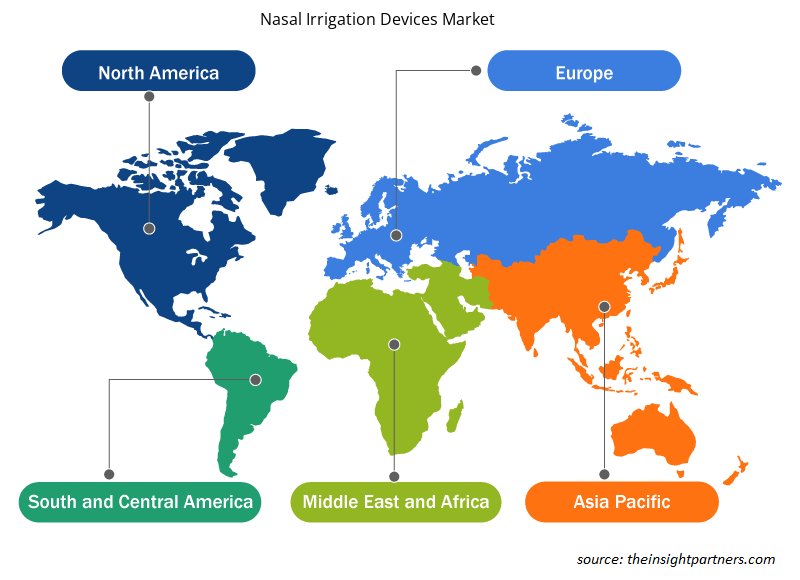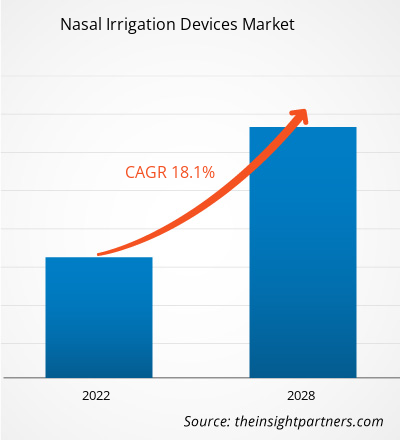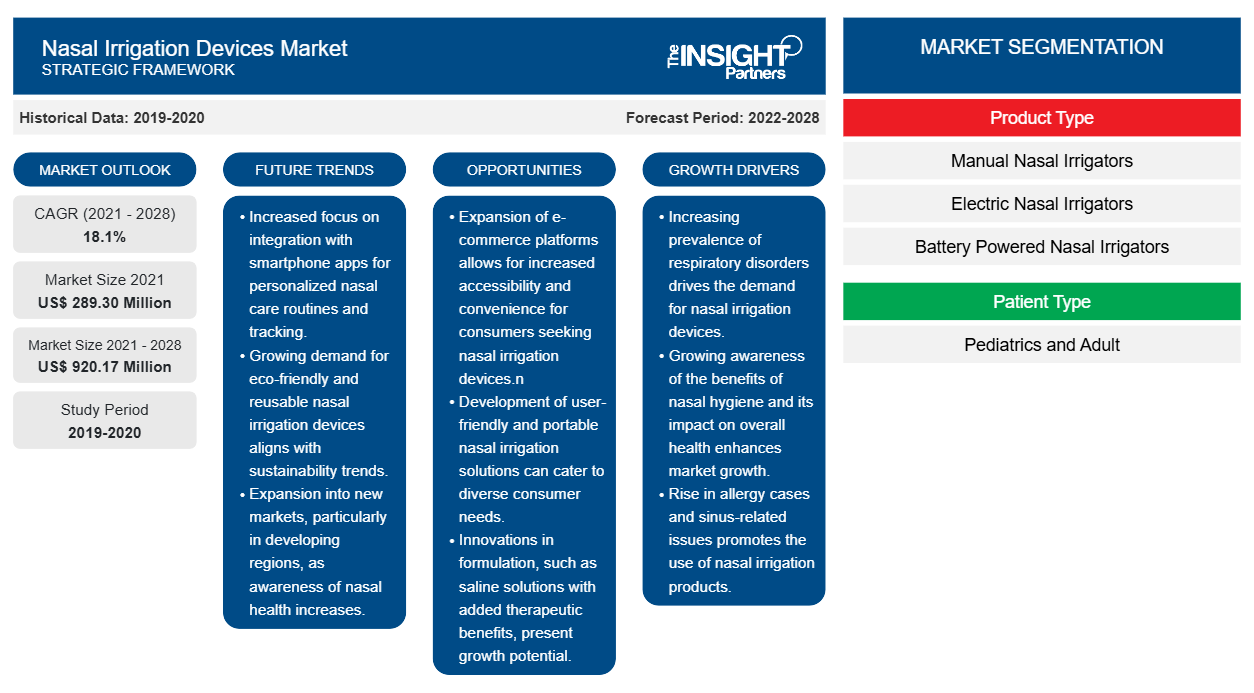Nel 2021, il mercato dei dispositivi per l'irrigazione nasale era valutato 289,30 milioni di dollari e si stima che crescerà a un CAGR del 18,1% dal 2022 al 2028.
L'irrigazione nasale è una pratica tradizionale di pulizia delle vie nasali con l'aiuto di soluzione salina e acqua distillata, utilizzando dispositivi come neti pot, flaconi a pressione e irrigatori nasali elettrici. Questi dispositivi hanno ugelli appositamente progettati che aiutano a pulire in modo efficiente ed efficace le vie nasali.
Il mercato dei dispositivi di irrigazione nasale è segmentato in base a tipo di prodotto, tipo di paziente, applicazione, utente finale e area geografica. In base all'area geografica, il mercato è ampiamente segmentato in Nord America, Europa, Asia Pacifico, Medio Oriente e Africa e Sud e Centro America. Questo rapporto offre approfondimenti e analisi approfondite del mercato, sottolineando parametri quali tendenze di mercato e dinamiche di mercato. Include anche l'analisi competitiva dei principali attori nel mercato dei dispositivi di irrigazione nasale.
Personalizza questo report in base alle tue esigenze
Riceverai la personalizzazione gratuita di qualsiasi report, comprese parti di questo report, o analisi a livello nazionale, pacchetto dati Excel, oltre a usufruire di grandi offerte e sconti per start-up e università
-
Scopri le principali tendenze di mercato in questo rapporto.Questo campione GRATUITO includerà analisi di dati che spaziano dalle tendenze di mercato alle stime e alle previsioni.
Approfondimenti di mercato
Aumento della prevalenza di allergie nasali e malattie infettive e crescente consapevolezza sui vantaggi dell'irrigazione nasale stimolano la crescita del mercato dei dispositivi di irrigazione nasale
Negli ultimi anni, si è verificata una crescita significativa nei casi di allergie e malattie infettive che colpiscono le vie respiratorie superiori. Si è verificato un aumento significativo di sinusite, rinite, bronchiolite e altre condizioni post-operatorie, che richiedono l'irrigazione nasale per una rapida guarigione; ulteriori infiammazioni e depositi batterici possono peggiorare le condizioni. Secondo un rapporto del Sinus & Allergy Wellness Center, la sinusite colpisce 30 milioni di adulti ogni anno negli Stati Uniti; circa l'11,6% degli adulti americani è stato diagnosticato con sinusite nel 2020. Pertanto, la crescente prevalenza di sinusite ha influenzato le attività di un individuo, favorendo la domanda di irrigazione nasale e guidando il mercato dei dispositivi di irrigazione nasale. Un aumento della prevalenza di infezioni delle vie respiratorie superiori in mezzo a un'industrializzazione a ritmo rapido e livelli di inquinamento in aumento sta anche alimentando la domanda di dispositivi di irrigazione nasale. Con l'aumento dell'inquinamento, gli allergeni e gli inquinanti presenti nell'aria possono causare l'ostruzione delle vie nasali e l'eccessivo deposito di tali sostanze o prodotti chimici può ulteriormente portare a sinusite e altri problemi nasali. I benefici dell'irrigazione nasale sono dovuti al fatto che favorisce l'eliminazione degli allergeni, estrae i fluidi, migliora la respirazione, libera i passaggi dei seni nasali, ecc. Ultimamente, la consapevolezza di questi benefici è aumentata tra i consumatori, traducendosi in un'elevata domanda di dispositivi di irrigazione nasale.
L'irrigazione nasale, che ora è adottata in tutto il mondo, ha una lunga storia che risale all'Ayurveda. Tuttavia, i dispositivi di irrigazione nasale si sono evoluti notevolmente dalle bottigliette a spruzzo ai neti pot. I dispositivi di irrigazione nasale elettrici e a batteria, che stanno guadagnando una notevole popolarità, consentono un flusso costante di acqua salina nella cavità nasale. Le economie in via di sviluppo nell'Asia Pacifica e nell'America meridionale e centrale si stanno concentrando sullo sviluppo e l'uso di tali dispositivi. PT Kalbe Farma Tbk ha lanciato il primo detergente nasale elettrico mai prodotto in Indonesia con il marchio Elvasense Portable Nasal Washer. Si prevede che il continuo sviluppo di nuovi dispositivi per risultati migliori e un aumento della produzione di dispositivi di irrigazione nasale nelle economie in via di sviluppo creeranno opportunità redditizie per la crescita del mercato durante il periodo di previsione.
Informazioni sul tipo di prodotto
In base al tipo di prodotto, il mercato dei dispositivi di irrigazione nasale è suddiviso in irrigatori nasali manuali, irrigatori nasali elettrici e irrigatori nasali a batteria. Il segmento degli irrigatori nasali manuali è ulteriormente suddiviso in neti pot, flacone squeeze e siringa a bulbo per bambini. Il segmento degli irrigatori nasali manuali ha detenuto la quota di mercato maggiore nel 2021. Tuttavia, si prevede che il segmento degli irrigatori nasali a batteria registrerà il CAGR più elevato durante il periodo di previsione a causa della tendenza crescente per i prodotti sanitari portatili.
Informazioni sul tipo di paziente
In base al tipo di paziente, il mercato dei dispositivi di irrigazione nasale è diviso in adulti e pediatria. Nel 2021, il segmento degli adulti ha detenuto una quota di mercato maggiore. Inoltre, si prevede che lo stesso segmento crescerà al CAGR più rapido dal 2022 al 2028. Il predominio di mercato di questo segmento è attribuito alla crescente domanda di dispositivi di irrigazione nasale per trattare infezioni dei seni nasali, allergie, raffreddori e influenza, soprattutto tra le crescenti popolazioni geriatriche in tutto il mondo.
Approfondimenti sulle applicazioni
In base all'applicazione, il mercato dei dispositivi di irrigazione nasale è segmentato in sinusite, rinite, bronchiolite, condizioni respiratorie post-operatorie e altri. Nel 2021, il segmento dei seni nasali ha detenuto la quota maggiore del mercato. Inoltre, si prevede che lo stesso segmento registrerà il CAGR più elevato dal 2022 al 2028. La crescita del mercato di questo segmento è attribuita alle crescenti condizioni dei seni nasali e alle iniziative intraprese dai principali attori.
Informazioni per l'utente finale
In base all'utente finale, il mercato dei dispositivi di irrigazione nasale è segmentato in contesti di assistenza domiciliare, ospedali e cliniche e altri. Nel 2021, il segmento degli ambienti di assistenza domiciliare detiene la quota maggiore del mercato e si prevede che registrerà il CAGR più rapido dal 2022 al 2028.
Sviluppi inorganici come fusioni e acquisizioni ed espansioni sono strategie ampiamente adottate dai player del mercato globale dei dispositivi di irrigazione nasale. Di seguito sono elencati alcuni dei recenti sviluppi chiave del mercato:
- A maggio 2022, Medtronic ha annunciato l'acquisizione di Intersect ENT, ampliando il portafoglio completo di otorinolaringoiatria (ORL) dell'azienda con prodotti innovativi utilizzati nelle procedure sinusali per migliorare i risultati postoperatori e trattare i polipi nasali. Le linee di prodotti e la base clienti di Intersect ENT promuoveranno gli sforzi di Medtronic per avere un impatto positivo sui pazienti affetti da rinosinusite cronica (CRS).
- Nel novembre 2021, NeilMed Phamaceuticals Inc. ha annunciato un'importante espansione dei suoi stabilimenti di produzione nella contea di Sonoma, in quanto le vendite sono in crescita, in particolare al di fuori degli Stati Uniti.
- Nell'ottobre 2021, Air Liquide ha annunciato l'acquisizione di Betamed SA, un importante fornitore di assistenza sanitaria domiciliare in Polonia, per sviluppare la propria attività di assistenza sanitaria domiciliare in Europa.
Approfondimenti regionali sul mercato dei dispositivi di irrigazione nasale
Le tendenze regionali e i fattori che influenzano il mercato dei dispositivi di irrigazione nasale durante il periodo di previsione sono stati ampiamente spiegati dagli analisti di Insight Partners. Questa sezione discute anche i segmenti e la geografia del mercato dei dispositivi di irrigazione nasale in Nord America, Europa, Asia Pacifico, Medio Oriente e Africa e Sud e Centro America.

- Ottieni i dati specifici regionali per il mercato dei dispositivi di irrigazione nasale
Ambito del rapporto di mercato sui dispositivi di irrigazione nasale
| Attributo del report | Dettagli |
|---|---|
| Dimensioni del mercato nel 2021 | 289,30 milioni di dollari USA |
| Dimensioni del mercato entro il 2028 | 920,17 milioni di dollari USA |
| CAGR globale (2021 - 2028) | 18,1% |
| Dati storici | 2019-2020 |
| Periodo di previsione | 2022-2028 |
| Segmenti coperti |
Per tipo di prodotto
|
| Regioni e Paesi coperti |
America del Nord
|
| Leader di mercato e profili aziendali chiave |
|
Densità dei player del mercato dei dispositivi di irrigazione nasale: comprendere il suo impatto sulle dinamiche aziendali
Il mercato dei dispositivi di irrigazione nasale sta crescendo rapidamente, spinto dalla crescente domanda degli utenti finali dovuta a fattori quali l'evoluzione delle preferenze dei consumatori, i progressi tecnologici e una maggiore consapevolezza dei benefici del prodotto. Con l'aumento della domanda, le aziende stanno ampliando le loro offerte, innovando per soddisfare le esigenze dei consumatori e capitalizzando sulle tendenze emergenti, il che alimenta ulteriormente la crescita del mercato.
La densità degli operatori di mercato si riferisce alla distribuzione di aziende o società che operano in un particolare mercato o settore. Indica quanti concorrenti (operatori di mercato) sono presenti in un dato spazio di mercato in relazione alle sue dimensioni o al valore di mercato totale.
Le principali aziende che operano nel mercato dei dispositivi di irrigazione nasale sono:
- Sistemi medici Air Liquide
- Società farmaceutica NEILMED INC.
- Società per azioni Stryker
- SinuPulse; Forza di guarigione
- Bremed limitata
Disclaimer : le aziende elencate sopra non sono classificate secondo un ordine particolare.

- Ottieni una panoramica dei principali attori del mercato dei dispositivi di irrigazione nasale
Profili aziendali
- Sistemi medici Air Liquide
- FARMACEUTICI NEILMED INC
- Società per azioni Stryker
- Sinupulso
- Forza di guarigione
- Società anonima Bremed Ltd.
- RhinoSystems, Inc
- Flaem Nuova SpA
- Medtronica SpA
- Bayer AG
- Analisi storica (2 anni), anno base, previsione (7 anni) con CAGR
- Analisi PEST e SWOT
- Valore/volume delle dimensioni del mercato - Globale, Regionale, Nazionale
- Industria e panorama competitivo
- Set di dati Excel
Report recenti
Rapporti correlati
Testimonianze
Motivo dell'acquisto
- Processo decisionale informato
- Comprensione delle dinamiche di mercato
- Analisi competitiva
- Analisi dei clienti
- Previsioni di mercato
- Mitigazione del rischio
- Pianificazione strategica
- Giustificazione degli investimenti
- Identificazione dei mercati emergenti
- Miglioramento delle strategie di marketing
- Aumento dell'efficienza operativa
- Allineamento alle tendenze normative























 Ottieni un campione gratuito per - Mercato dei dispositivi di irrigazione nasale
Ottieni un campione gratuito per - Mercato dei dispositivi di irrigazione nasale